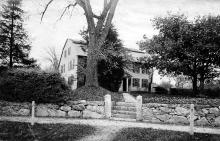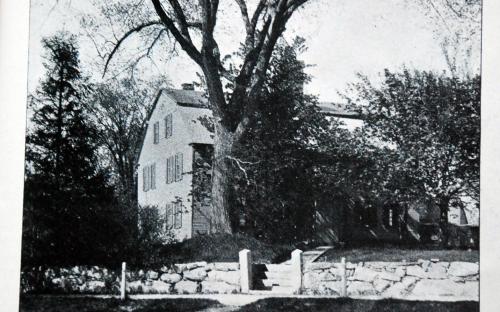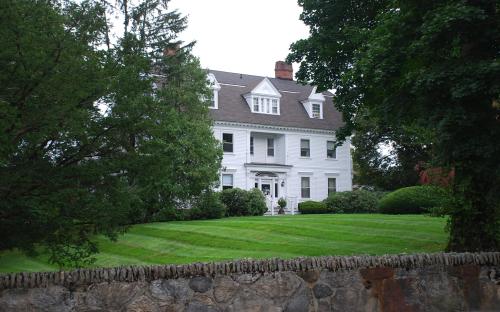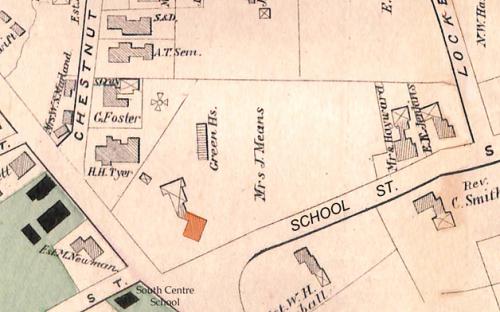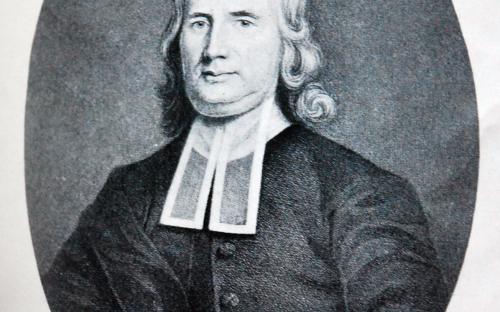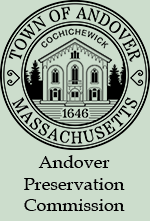Architectural Description:
A first period home built with a gambrel roof, one of a few of this style to be built in Andover.
Historical Narrative:
53 School Street - Old Parsonage lot – now 36 Central St. built 1710
On the northeast corner of School and Central Streets is the former mansion of Esther H. (Smith) Byers. The property is listed as 36 Central Street and her house now contains eight condominiums. Esther, born October 19, 1836, was the daughter of Peter & Esther (Ward) Smith and the widow of John Byers who had died in1888 at age 57. The Byers lived in New York City and summered in Andover. Esther purchased the property on March 16, 1891 which contained 5 acres and the old South Parish Parsonage. Mrs. Byers hired noted Boston architect A. W. Longfellow to design a new mansion on the site and razed the old historic South Parish Manse in July 1891. Her new home however was an architectural nod to the style of the old Manse.
The South Parish of Andover was created in 1709. The Parish built their Meetinghouse in 1710, at 41 Central St., now occupied by the forth meeting house, South Church, to be erected on the site. The Parsonage was completed in 1711 and built diagonally across the street. The Parish was also granted 94 acres of land in the central area of the Meeting house.
In the construction of the Manse it was “Voted to be “forty three feet long, twenty feet wide, and fourteen feet stud.” Taxes were levied, from time to time, to clear the land and break it up, to plant an orchard, to dig the well and make a fence.” Over time various changes were made in the house and its outbuildings by the Parish. A committee was annually appointed to have the care of it, together with that of the other property. A stone Chimney was built in it in 1754. The same year sash-glass took the place of the “diamond-glass, set in lead. It was first painted in 1757. Through repairs were made again in 1773.
The first minister to occupy the Parsonage was Rev. Samuel Phillips who began his pastorate at age 22 on Oct. 17, 1711. Rev. Phillips served as pastor for 59 years until his death in 1771. Samuel was born in Salem, MA on Feb. 17, 1689, son of Samuel Phillips, a goldsmith, and Mary (Emerson) Phillips.. Samuel graduated from Harvard College in 1708 and was ordained on Oct. 7, 1711. Samuel married in Andover to Hannah White on Jan. 17, 1712. Hannah was the daughter of the Hon. John White of Haverhill, MA. They had six children: Mary bpt. Dec. 7, 1712, Samuel bpt. Feb. 13, 1715, Lydia bpt. June 16,. 1717, John b. Dec. 27, 1719, and William b. June 25, 1722. All the children grew up in the Manse. Two sons, Samuel and John were respectively the founders of Phillips Academy Andover 1778 and Phillips Academy Exeter 1780.
Rev. Philips was “a decided and zealous Calvinist, in strictest conformity to the Westminster Catechism, …yet with these strong doctrinal opinions, he was able to unite his own people and maintain fellowship with the neighboring clergymen of a looser and dangerous creed.” He was however beloved by his parishioners.
“The Parish were very kind to their minister and cheerfully furnished him with abundance of fuel from the parsonage lots. Then back-logs were expected to burn all night in the spacious fire-place, and wood was plentiful. We have reliable information, that on occasion in good sledding the parishioners fastened their sleds together and with sufficient number of yokes of oxen merrily conveyed the connected loads to the parsonage. According to the fashion of former times at the quilting-bee, husking-bee, raising-bee, and on this occasion hauling-bee, a supper was prepared for the persons engaged in united and beneficial manor.”
Also in Rev. Phillips household were two slaves, “Negro servants” named Salem & Rema. On Sunday when the Phillips family went to church “Madam Phillips walked, leaning on her husband’s arm, from the parsonage to the meeting-house, Mr. Phillips having his negro man-servant at his right hand, and Madam Phillips her negro maid-servant on her left.. The family followed them in procession, according to age.” We know that Salem & Rema were married on Oct. 16, 1760 by Rev. Phillips and they had three sons; Cato b. May 26, 1768, Cyrus bpt. Dec. 23, 1770, age 6 weeks 2d, and Titus b. Nov. 24, 1774.
Rev. Samuel Phillips died at age 82 on June 5, 1771. Hannah Phillips outlived her husband by two years and is interred in the family lot at South Parish Cemetery. Salem & Rema remained at the parsonage then becoming the servants to Rev. Jonathan French, the second minister called to the Parish in 1772. Massachusetts abolished slavery in their State Constitution on 1780 and the transition of Salem & Rema from slave, to servant, to emancipation took place during Rev. French’s service to the Parish.
Rev. Jonathan French b. Jan. 30, 1730 in Braintree, MA, enlisted as a private at age 17 in the French & Indian War and served at Ft. Edward and Castle William at the rank of Sergeant. He later resigned and entered Harvard College graduating in 1761.
Jonathan was 32 when he came to Andover and served 37 years from Sept. 23, 1772 until his death at age 70 on July 28, 1809. Jonathan married on June 18, 1773 to Abigail Richards of Milton, daughter of Dr. Benjamin Richards of Weymouth. Their children: Sarah b. Nov. 18, 1774- Nov. 26, 1774, Abigail b. May 29, 1776, Jonathan b. Aug. 16, 1778, Mary Holyoke b. Aug. 6, 1781, Sarah b. Dec. 13, 1784- d. Apr. 12, 1788. Rev. French was “guiding the congregation through the Revolutionary War and the building of a new meetinghouse in 1788.”
The Honorable Josiah Quincy, was an alumnus of Phillips Academy and President of Harvard College. He wrote about his life in Andover while attending the academy; (March 14, 1855 Andover Advertiser) “At the time of the erection of the meeting-house, a parsonage was also built……It is no longer used as a parsonage, but occupied as a private residence. Its quaint construction and its pleasant situation, the beautiful lawn and arching elm trees, as well as its historic associations, make it one of the most interesting places in Andover.”
“Mr. French’s home was noted for its hospitality, although frugal, as was necessary in the “bad times”, into which the country was brought after the war.”
“Mr. French, like other clergy of his day, had almost always in his family some young men as students, both those who were in the Academy and others preparing for the ministry” J. Quincy.
In 1794/1795 Abigail French, age 18, daughter of Rev. French, wrote a letter to her brother Jonathan. “papa has bought the schoolhouse on the plane (the old Osgood school) it was taken down & brought here to-day. Mr. Jacob Osgood & his neibours assisted in takeing it down & bringing it for nothing it is to be put over in the orchard and Remy is to move in as soon as it is done.”
It is not clear if a separate house for Rema and Salem in the orchard was finally an acknowledgement of their right of freedom and to live separately, but continued to serve the household. Rema’s death was not recorded but Salem Phillips died at the Alms House on April 19, 1815 at the age of 90.
As early as 1803 the Parish consulted with Mr. French to see if he was ‘willing that any part of the parsonage land should be sold for house-lots.” That year it was twice voted not to sell, if Mr. French was willing. Rev. Jonathan French died on July 28, 1809 and is interred at South Cemetery. His widow Abigail died Aug. 28, 1821 age 79. On December 25, 1809, five months after his death, a committee was authorized to petition the Legislature for the liberty to sell the Parish lands. On Feb. 16, 1810 the following petition was submitted; “An act to authorize the sale of parsonage lands, in the South Parish, in the town of Andover, in the County of Essex, to raise a fund for the support of the gospel ministry, in said Parish, and to appoint Trustees for the management thereof.” The petition passed the Legislature and the creation of “a body politic and corporate, by the name of The Trustees of the Ministerial Fund in the South Parish in Andover” was established. The first Trustees were; Samuel Farrar, Joshua Chandler, Benjamin Jenkins, Daniel Cummings, Jacob Osgood, David Abbot and Simeon Furbush. As there were no banks in Andover at that time, the fund was borrowed from often by the parishioners for mortgages or improvements to property. The parsonage lands at that time fifty-four acres, were sold off by the newly created “Ministerial Fund.”
The Andover Advertiser published “Recollections of Andover” by Josiah Quincy in 1858. I have included the complete letters as they give an accurate description of the Parsonage and traveling down School Street in 1778 and again in the 1840s.
Recollections of Old Andover as it was Eighty Years Ago. [1778]
By Hon. Josiah Quincy
“In the winter of 1854-5, Mrs. H. B. Stowe, of this town, published a series of articles in the Independent of New York, containing some life-like pictures of Andover localities and scenery. These called forth the following interesting and beautiful letter from the Hon. Josiah Quincy. As the semi-centennial anniversary of the Theological Seminary, which is in fact but a branch of the old Phillips Academy, is now approaching, Mr. Quincy has been requested to allow his recollections to be published. To this he has kindly consented, provided his whole letter be printed as he wrote it. This wish of the venerable author is scrupulously complied with in the copy herewith presented. Mr. Quincy was a trustee of the institution for 26 years, from 1802-1828 when he was elected to the Presidency of Harvard College. – Editors.”
Boston March 14, 1855 - Josiah Quincy letter to Harriet Beecher Stowe
“Andover Advertiser”
My earliest distinct recollection of Andover was in 1778, when I entered the Academy, the twenty-seventh scholar, after the first opening, being then in the seventh year of my age.”… …Between the Academy and the parsonage and the church, there was no house. On the right was a dense wood, and on the left an undulating pasture; on each side of the road were stone walls, where the striped squirrel, and occasionally a woodchuck would find harbor, whom it was the sport and the business of us boys, to rouse and to pursue.
There was then to be seen from your “Mount Clear” no city of Lawrence, in the distance. “throwing shafts of light” from its windows, no ranges of mills or towers looking like places of an Italian city. Nature had then no competitor to divide with her interest of the scene. The oak, the pine, the ash, and the hemlock contended together for the mastery; under their thick spreading branches every path was tangles by the prickling blackberry, or the creeping vine, under cover of whose matted leaves progress was slow and careful, lest mayhap you might tread upon the black snake in his couch, or the wild bee in her nest. From the Academy to the parsonage, I traveled backward and forward for eight years, four times a day. Mr. French, the pastor, was to me a friend and father. I knew him well.
“A man he was to all the country deed,
And passing rich with forth pounds a year.”
I should delight to speak of his worth and his virtue, but my business now is not with persons, but localities.
The parsonage was a respectable mansion, with a front yard, surrounded by a board fence, and had two glorious elms, natives of the ancient forest, who lovingly intermingled their branches, like Baucus and Philemon, and held in their embraces the nest of the robin, the sparrow, and the thrush. When I last visited the spot the trees had been levelled by some Vandal, and also, There was no garden flower, no shrub whose presence could-
“the place disclose,
Where once the village preacher’s modest mansion rose.”
And what remained of the old building was time-worn and neglected. A rascally railroad run vaunting under its windows, separating the parson’s house from the old garden,* where was a venerable rock, covered with grape vines, the subjects sometimes of the boys’ labors, and sometimes of their plunder.
*Editors Note - Since Mr. Quincy’s visit alluded to above there has been a great change in the premises and decidedly for the better. The railroad has been removed into the valley west and entirely out of site, the old parsonage house has been put in appropriate repair, and the grounds handsomely laid out and cultivated. The old rock, though somewhat diminished in size, is still there, and is now held in the embrace of a direct descendant of the original grapevine - Editors.
The railroad mentioned in his letter was the Andover–Wilmington Railroad 1837-1848, that ran along Abbot Street crossing School Street and running through the south and rear yard of the former parsonage. It then crossed Central Street near the intersection of Chestnut St. and stopped at the depot on Essex Street, at the rear entrance to Memorial Hall Library.
The Ministerial Fund sold the Parsonage with 5½ acres on Apr. 1, 1816, to Rev. Justin Edwards D.D. for $2000. It appears the old Manse may have been occupied by Rev. Edwards, the third minister of South Parish for about four years. Rev. Edwards served from Dec. 2, 1812 – Oct. 1, 1827. He purchased both the Parsonage and the Abbott Walker homestead at 71 Main St. on April 1, 1816. The Edwards family then moved to the Walker home at the corner of Chestnut and Main Streets. The house was located on the site of the former Post Office and now the Santander Bank. The former Parsonage was later sold to Timothy Osgood, and rented to Dr. Daniel Wardwell for 35 years
Dr. Daniel Wardwell lived in the old parsonage from 1816 until his death on April 14, 1851 of consumption at age 66 years. Dr. Wardwell never owned the former Manse, as it was purchased by his father-in-law, Timothy Osgood (Sally) on Nov. 25, 1824 and then to his son Henry Osgood on May 4, 1835.
Daniel was born Jan. 11, 1785 in Hollis, NH, son of Solomon & Bethiah (Holt) Wardwell. Daniel had a practice in Lydenborough, NH before moving to Andover. He married on Sept. 24, 1816 to Sarah “Sally” Osgood of Andover b. Sept. 9, 1789 dau. of Timothy & Sarah (Farnum) Osgood. Their children; William Henry b. Oct. 24, 1818 NH, Sarah Marie b. Mar. 1821-Sept. 13, 1839, Octavia Susan b. July 8, 1824, Timothy O. b. Aug.1827 - d. Nov. 25, 1827 3m., son. Nov. 21, 1828, and Timothy Osgood b. Nov. 22, 1829-May 19, 1851 San Francisco, CA age 22.
Octavia Susan Wardwell - b. July 8, 1824 – died April1, 1897
AT April 9, 1897 p. 8 North Andover News
Obituary. A Card. MISS OCTAVIA SUSAN WARDWELL. The death of Miss Octavia Susan Wardwell, which occurred very suddenly from paralysis at the home of Miss Charlotte Abbott, Punchard Ave, Andover, Thursday evening, closed the ancestral line of a family whose lives have been, at different times, prominent in the history of town and nation. Deceased, who was in her 72nd year, was the daughter of Dr. Daniel Wardwell, of Hollis, N.H, and Sarah Osgood of the South Parish. After some years of practice in Lyndeborough, NH., the doctor settled in Andover, residing in the "Old South" parsonage, and it was there the deceased was born, and while Andover has been considered her home, yet she was accustomed to spend considerable time here in the Henry Osgood house on Osgood Street. Miss Wardwell was a woman of high moral principles and was of a very kind and charitable disposition. She was received as the one hundred and eighty ninth member of the Congregational Church from the Free Church, Andover, during the pastorate of Rev. William Torrey Briggs, Nov. 1, 1857. She is the last member of her family, which included three brothers, and a sister, other than herself. Rev. Howard Osgood of Rochester, N. Y., the eminent theologian, is a cousin. A nephew, T. Osgood Wardwell of town, also survives her. Funeral services were held Monday afternoon, at the home of Miss Wood in Andover, Rev. Mr. Shipman officiating. The body was brought here and Interred in the family lot at Ridgewood Cemetery, North Andover.
George Henry French purchased the house for $4000 on Sept. 8, 1851. George was born in Andover on Feb. 2, 1825, son of George and Mary (Richardson) French. George was a merchant and leather dealer. George was living in Boston when he married on Sept. 27, 1849 in Taunton, MA to Frances “Fanny” Wood Morton b. Jan. 16, 1828 Taunton, daughter of Judge Marcus & Charlotte (Hodges) Morton.
George and Fanny had three children while living in Andover: Alice b. Mar. 19, 1850, Morton b. June 25, 1851, and Nathaniel b. Sept. 7, 1854. The French family is listed in Andover in the 1850 and 1855 census. Fanny’s brother Marcus Morton Jr. purchased the brick house at 23 School St. in July 1850.
Fanny had attended Abbot Academy as did her daughter Alice. George held the property a little over five years then to James Means of Groton MA on May 14, 1856 for $6100, of which a $3000 mortgage was held by Henry Osgood. French then moved to Davenport, Iowa. They had two more children, George Watson b. 1856 and Robert Tillinghast b. 1871. Their daughter Alice became an author using the pen name “Octave Thanet”
Andover Advertiser (AA) – May 21, 1853. - Messrs. Peter Smith and Geo. H. French have just completed very elegant Green Houses, which invite the admiration of lovers of tasteful structures.
AA - Who would recognize the “Old Parsonage” whilom so barren and treeless all about it, with its fresh green lawn in front, and substantial stone wall and other valuable additions.
Rev. James Means purchased the Old Manse on May 14, 1856, for $6100, when he was living in Groton, MA. James was born April 17, 1813, at Amherst, NH and graduated at Bowdoin College in 1833. James was teacher in the Preparatory Department of Bangor Theological Seminary, then entered Andover Theological Seminary in 1835, spent his fourth year in 1838 as Abbot Resident. James married Jan. 30, 1840, in Andover to Elizabeth P. Johnson b. Mar. 20, 1814, in Johnstown, NY dau. of Caleb & Phebe (Coan) Johnson. James was ordained in 1840 in Concord and then became Principal of Lawrence Academy in Groton, MA from1842 to 1852. After a year abroad he taught then elected Assistant Principal, in the Springer Institute, New York City. He was then Principal of Tilden Female Seminary, West Lebanon, NH and in 1860 moved to Auburndale, MA.
“In June, 1861, he was appointed Chaplain of the Academy Green Hospital at Newburn, NC. On the first of January 1863, he was appointed "Superintendent of Blacks of the Department of North Carolina," with the rank of Captain in the United States service. In this office his labors were severe and exhaustive. They soon wasted his system. On the fifth of March he was attacked with a fever, which confined him to his sick-room nine days. On the 17th of March he resumed his duties, but on the 20th suffered a relapse; and, after lingering until the evening of the 6th of April he breathed his last, with sweet resignation and serenity. During the last hour of his life, a regimental band were playing several favorite airs near his sick room; and, although ignorant of his illness, the band was playing the tone "Home, sweet home," at the very moment of his departure.”
Rev. Means died of Typhoid fever and his remains were returned to Auburndale for the funeral services on Thursday and Friday afternoon he was buried in Andover from the South Church. He was a remarkable man and loved by all who knew him.
James and Elizabeth had four children; Catherine Atherton “Kate” b. Aug. 20, 1841, Elizabeth “Lilla” B. b. March 14, 1844, both in Concord, MA, Daniel McGregor b. May 1, 1848 in Groton and Emily Adams b. April 5, 1850, in Cambridge. After James untimely death in 1863, his estate went to his Widow Elizabeth and their children.
Elizabeth held a life tenancy on the property, and the Means family owned the house for 35 years. All their daughters lived with her in this home. The 1880 Census lists Kate as a Porcelain painter, Lilla as teacher of music and Emily A. as a Portrait painter. Emily Adams Means built a studio in the garden on the property. Emily was also the Principal of Abbot Academy from 1898 to 1911 and died in June 1922. Son David graduated from Phillips Academy and Yale College, was a teacher at Middlebury College, a lawyer and author. Elizabeth Means died Jan. 9, 1890, at age 75 years 9m and is interred in South Parish Cemetery with James.
The Means family was the last to occupy the former Parsonage. The children: Catherine A., Lilla B., Emily A. and David McGregor Means inherited the property, and the following year sold it to Esther H. Byers on March 16, 1891. The property still contained five original acres extending up School and Central Streets and to the rear of the house. The old Parsonage was 181 years old when it was razed. All was not lost however, as Mrs. Byers saved “the fireplace and woodwork of the mantel were removed and installed in the dining room of her new Mansion”.
Andover Advertiser – July 3, 1891 – The work of tearing down the Means house on the corner of Central and School streets is about finished.
Bibliography/References:
Essex County Registry Deeds, Salem, MA
North Essex County Registry Deeds, Lawrence, MA
Historical Sketches of Andover, 1882 by Sarah Loring Bailey
Andover Advertiser 1853 - 1906 - Obituaries, news items
Andover Townsman -Obituaries, news items
Andover Center for History & Culture vertical files
South Parish Church Records
South Parish Cemetery Records
Andover Vital Records - Births, Marriages, Deaths
Ancestrey.com - Family Genealogies
Occupants - Owners:
South Parish Church - 1710 - 1815
Rev. Samuel Phillips - Oct. 17, 1711 – June 5, 1771 – 60 years, age 82.
Rev. Jonathan French - Sept. 23, 1772 – July 28, 1809 – 36 years, age 70
Rev Justin Edwards, D.D. - Dec. 2, 1812 – Oct. 1, 1827
South Parish Ministerial Fund - Feb. 16, 1810
Rev. Justin Edwards - Apr. 1, 1816 - b. 224 leaf 93 -$2000 - 5½ acres
Rev. Justin Edwards - July 7, 1816 - b. 224 leaf 93-94 - $585 - 7a 128 rods
Elijah L. Herrick - Dec. 1, 1817 - b. 218 leaf 234 - $2000
Peter French
William Richardson (Sarah) - Jan. 1, 1824 - b. 234 leaf 161 - $3000 (+600 mtg)
Peter French (Elizabeth) - Nov. 10, 1824 - b. 237 lf. 205 (+$600 mtg)
Timothy Osgood (Sally) - Nov. 25, 1824 - b. 237 lf. 205 - $3500
Henry Osgood - May 4, 1835 - b. 286 lf. 92 - $4000
George H. French - Sept. 8, 1851 - b. 450 lf. 144 - $4000
James Means - May 14, 1856 - b. 531 lf. 231 - $6100
James Means estate - died Apr. 6, 1863 probate
Elizabeth Means, wid. life estate - 1863 - died Jan. 9, 1890
Means Heirs, Catherine A., Lilla B., Emily A., & David McGregor Means – Jan. 9, 1890
Esther H. Byers - Mar. 16, 1891 - b. 111 p. 424 - 5 acres - Old Parsonage razed June 1891
Eshter H. Byers House - Built 1891 -
Esther H. Byers estate died March 21, 1904
Peter Smith, heir - 1904 - Probate Will
Ella V. Cann - May 31, 1905 - b. 221 p. 48
George W. & Ella V. Cann - Apr. 23, 1914 - b. 340 p. 289
Jerome Cross - Oct. 12, 1916 - b. 369 p. 267
Herman H. Petzold - June 19, 1940 - b. 631 p. 292
Herman H. Petzold - Nov. 29, 1961 - b. 949 p. 193
Karl C. & Geneva H. Killorian - Dec. 23, 1966 - b. 1074 p. 312
Geneva H. Killorian - Aug. 12, 1982 - b. 1596 p. 259
Geneva H. Killorian 1992 Trust, Eric Killorian Trustee - Mar. 27, 1992 - b. 3440 p. 336
36 Central Street Condominiums - Oct. 31, 2008 - b. 11363 p. 176-204 master deed
Inventory Data:
| Street | School St |
| Place | Andover Center |
| Historic District | Andover Village Industrial NRH District |
| Historic District | Ballardvale Local Historic District |
| Historic District | Ballardvale National Register District |
| Historic District | Central Street NRH District |
| Historic Name | South Parish Parsonage |
| Present Use | residence |
| Original Use | Residence - Parsonage |
| Construction Date | 1711 |
| Source | ECRDS, ENRDL, |
| Architectural Style | First Period |
| Architect/Builder | South Parish |
| Foundation | stone, granite |
| Wall/Trim | clapboard/wood |
| Roof | Grambrel/wood |
| Outbuildings / Secondary Structures | Barn, sheds, studio, greenhouse |
| Condition | Razed |
| Demolished? | Yes |
| Demolition Details | June1891 |
| Acreage | 5.5 acres |
| Setting | Residential |
| Recorded by | James S. Batchelder |
| Organization | Andover Preservation Commission |
| Date entered | October 12, 2025 |
